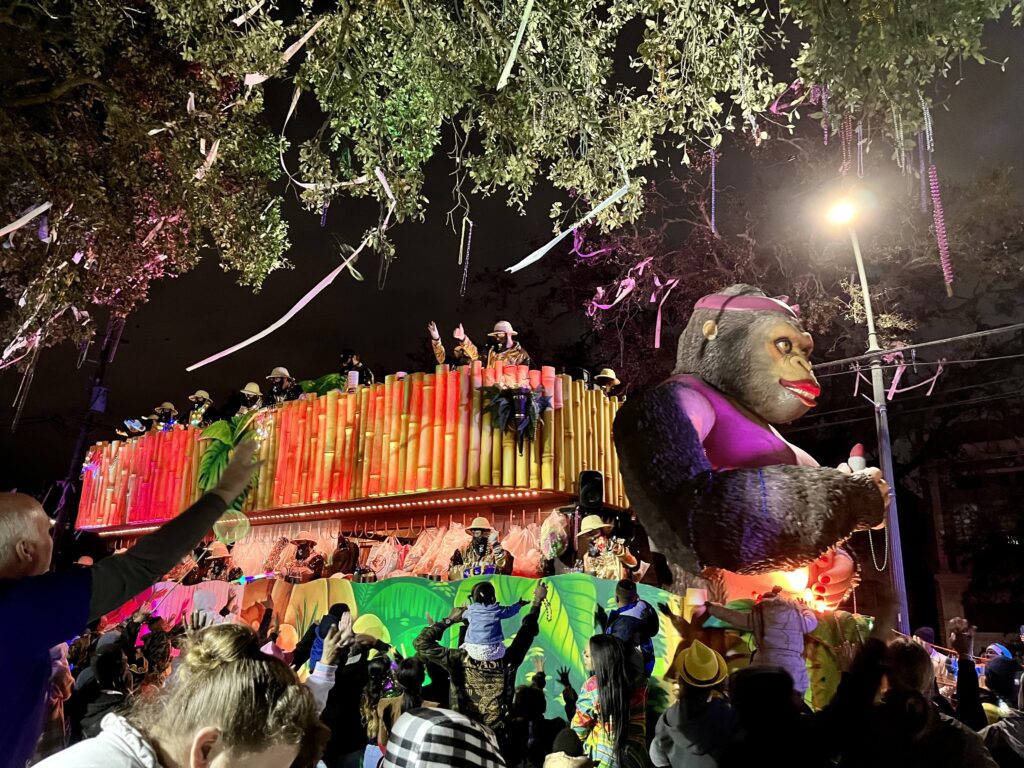You wake up to the sound of jazz music droning in the distance and the smell of beignets wafting to you from the café at the end of the block. You turn over drowsily, and a sparkle catches your eye. The light streaming through your window is reflecting off the beads hanging from your curtain rod and dancing hues of purple, green, and gold across your wall. An excitement rises within you; it’s time to get ready for today’s parades! You don your parade gear, down a cup of coffee, and head into a world of color and light.
Mardi Gras in New Orleans is pure magic. The best kind of sensory overload. A celebration of the beautiful chaos that is life itself. This grandiose celebration dates back to the 17th century, originating in medieval Europe1. It first made an appearance in Louisiana in 1703 in Fort Louis de la Mobile, a tiny settlement established by French-Canadian explorer Jean Baptiste1. The city of New Orleans was established in 1718 and by the 1730s Mardi Gras was celebrated openly in the city1. Mardi Gras continued to evolve throughout the years, and in 1870, an account of the first ever “throws” was recorded1. The colors of Mardi Gras were established soon after, where purple stands for justice, gold for power, and green for faith1. Now, Mardi Gras is known as the “Greatest Free Show on Earth”, spanning several weeks with over 40 processions and numerous parade krewes1.
 Image of a parade float with a gorilla at the front.
Image of a parade float with a gorilla at the front.
However, such a grandiose celebration has its costs. As fun and innocent as it is to catch beads, cups, feather boas, socks, even decorated toilet plungers, the aftermath is not so carefree. Every year in New Orleans, about 1,000 tons (2.6 million pounds) of trash is generated from Mardi Gras2. This is equivalent to ~333 pickup trucks or ~165 million plastic grocery bags. In fact, in 2018 the Mardi Gras pollution became such a problem that the city had to pull 40 tons of beads from the storm drains2. Furthermore, some of the beads have been found to contain toxins such as lead and flame retardants2,3.
 Trash, such as beads, cups, cans, and bottles, litters the parade route.
Trash, such as beads, cups, cans, and bottles, litters the parade route.
Some organizations and krewes have advocated for a “greener” Mardi Gras by transitioning to locally sourced throws and biodegradable beads and setting up recycling stations3. It’s a great start, but greener bead alternatives can become expensive and recycling stations must be properly maintained in order to be successful. So what else can Mardi Gras throwers and goers do to continue celebrating this fun-filled season while also creating less of a negative environmental impact?
One idea is to incorporate more consumables as throws. When I attended Mardi Gras a few weeks ago, one krewe was throwing small bags of locally made coffee and let me tell ya, my caffeine-motivated brain was pumped at the idea of free brew! Another idea is to incorporate reusables: reusable straws, cups, bags, and bottles (to name a few) seem to be all the rage these days and serve as useful and practical souvenirs. Finally, throws could be more intentional. So many throws end up on the ground, and is it necessary to leave each parade with 20 pounds of beads around one’s neck? Waiting for an intentional and targeted throw could make the prize feel that much more rewarding!
Do you have your own musings about green alternatives for Mardi Gras throws? If so, I would love to hear about them in the comments 😊
-Zo

